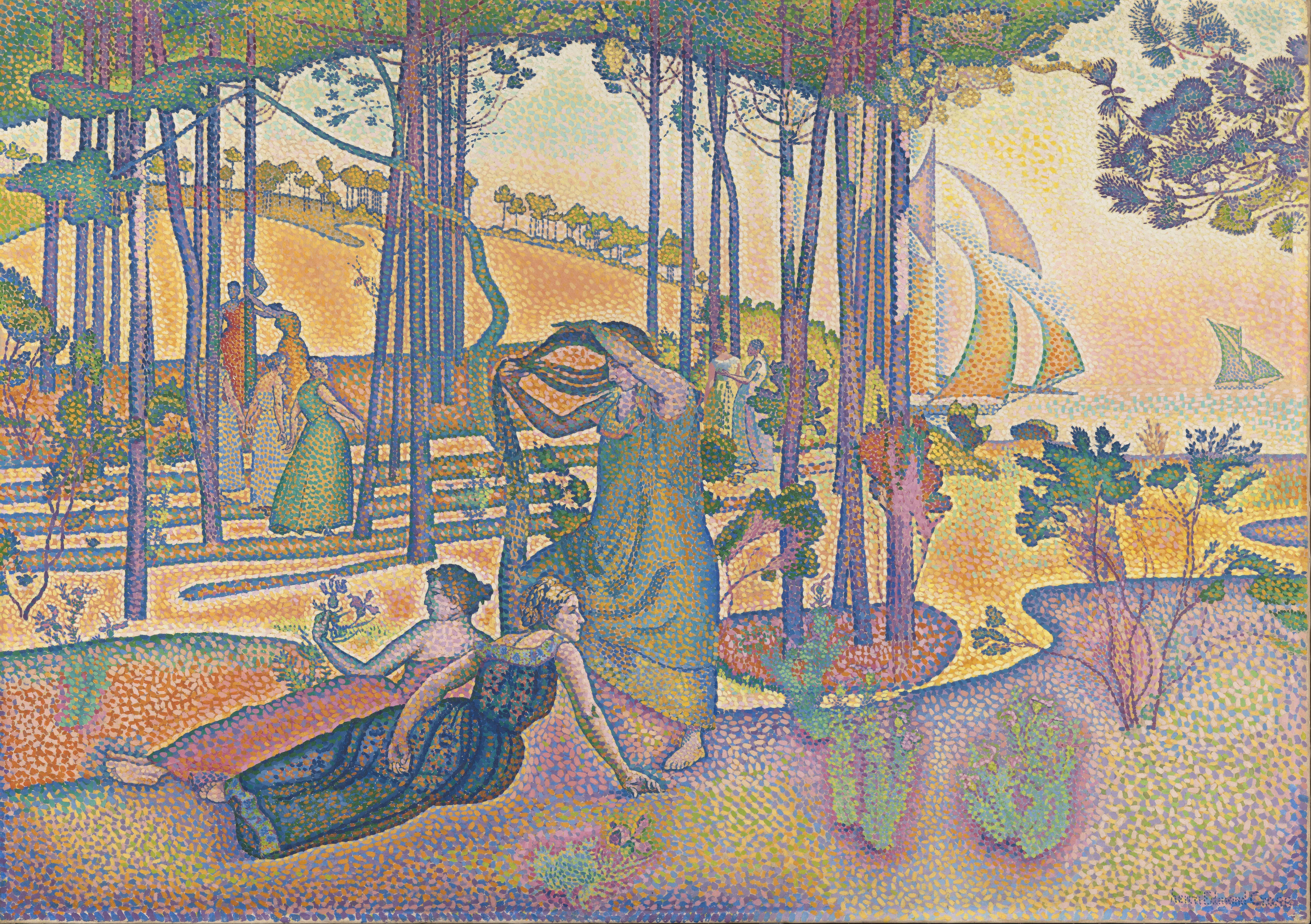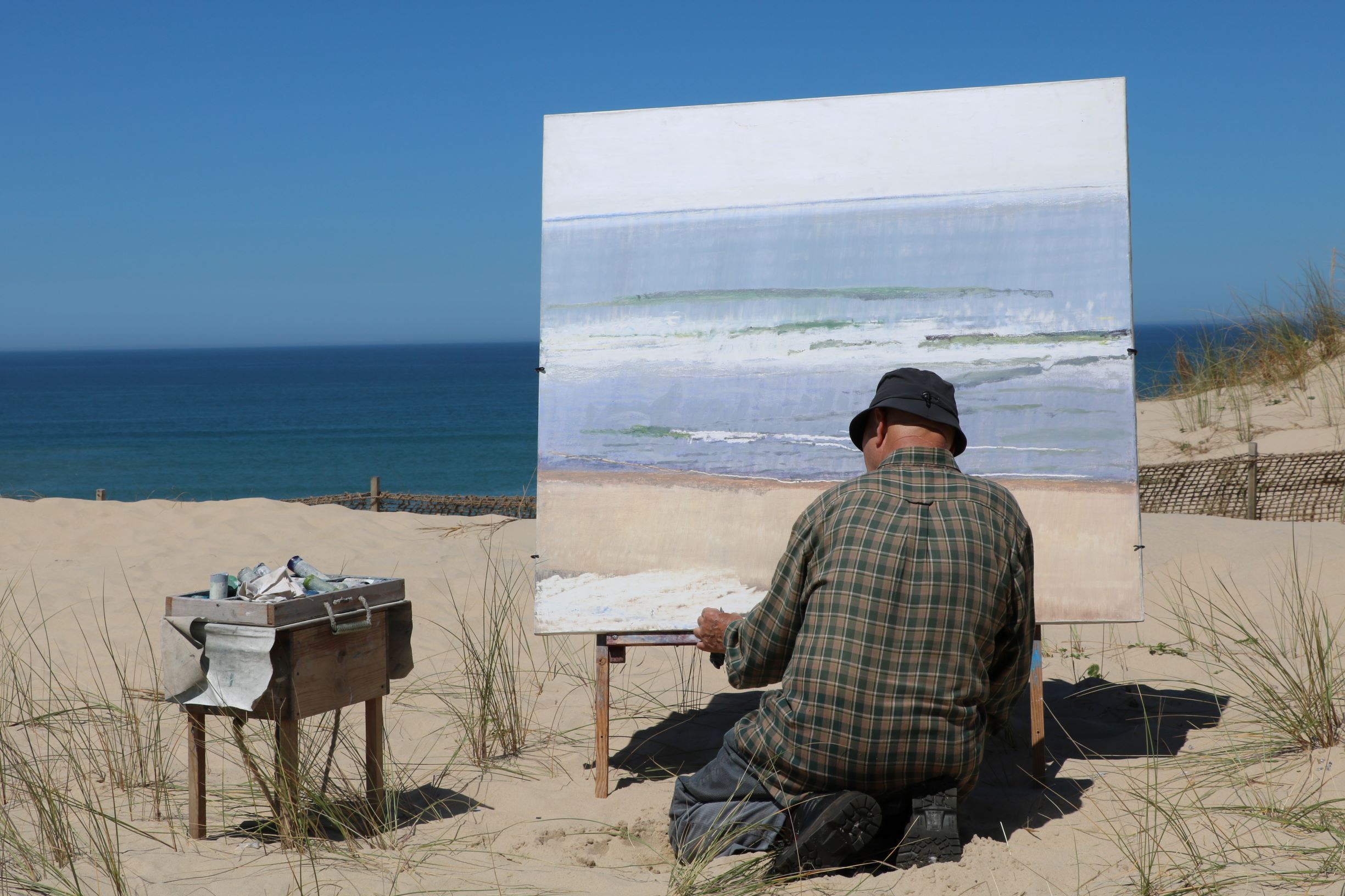|
Florent Crabeels
Florent Nicolas Crabeels (5 December 1829, Antwerp – 7 June 1896, Antwerp) was a Belgian Genre art, genre and landscape painter. Life and work He studied at the Royal Academy of Fine Arts (Antwerp), Royal Academy of Fine Arts in Antwerp, with Jacob Jacobs (artist), Jacob Jacobs and Egide Linnig. At first, he painted scenes from villages and small town markets. Later, he turned to landscapes from the Campine, Kempen region, and became an ardent supporter of painting Plein aire, en plein air. Much of his work was done in the artists' colony at Wechelderzande, together with , Jacques Rosseels (1828–1912), and Adriaan Jozef Heymans; a member of the of landscape painting. In 1886, he was one of the founding members of "L’Art Indépendant". He became a Neo-Impressionist and returned to painting genre scenes around 1890. In addition to being a painter, he was also well known as an engraver. Sources * Paul Bergmans: "Crabeels, Florent Nicolas". In: Ulrich Thieme (Ed.): ''All ... [...More Info...] [...Related Items...] OR: [Wikipedia] [Google] [Baidu] |
Antwerp
Antwerp (; ; ) is a City status in Belgium, city and a Municipalities of Belgium, municipality in the Flemish Region of Belgium. It is the capital and largest city of Antwerp Province, and the third-largest city in Belgium by area at , after Tournai and Couvin. With a population of 565,039, it is the List of most populous municipalities in Belgium, most populous municipality in Belgium, and with a metropolitan population of over 1.2 million people, the country's Metropolitan areas in Belgium, second-largest metropolitan area after Brussels. Definitions of metropolitan areas in Belgium. Flowing through Antwerp is the river Scheldt. Antwerp is linked to the North Sea by the river's Western Scheldt, Westerschelde estuary. It is about north of Brussels, and about south of the Netherlands, Dutch border. The Port of Antwerp is one of the biggest in the world, ranking second in Europe after Rotterdam and List of world's busiest container ports, within the top 20 globally. The city ... [...More Info...] [...Related Items...] OR: [Wikipedia] [Google] [Baidu] |
Adriaan Jozef Heymans
Adriaan Jozef Heymans (or Adrien-Joseph Heymans; 11 June 1839 in Antwerp – December 1921 in Brussels) was a Belgian impressionist landscape painter. Biography His father was a trader in window-glass, who died when Heymans was only seven. Afterward, he was partly raised by his uncle, the mayor of Wechelderzande, a small village near Antwerp, where he first learned to appreciate nature. In 1853, he entered the Royal Academy of Fine Arts of Antwerp, where he studied under Jacob Jacobs, later attending the Académie Royale des Beaux-Arts in Brussels, but he always considered himself to be essentially self-taught. During a stay in Paris from 1855 to 1858, he was strongly influenced by the Barbizon School. By the time of the Brussels Salon in 1860, he was turning toward impressionism. He soon returned to Wechelderzande and began painting plein air, both there and in the vicinity of Kalmthout. Many other painters came to the Kempen area seeking inspiration; often living in t ... [...More Info...] [...Related Items...] OR: [Wikipedia] [Google] [Baidu] |
Belgian Landscape Painters
{{Disambiguation ...
Belgian may refer to: * Something of, or related to, Belgium * Belgians, people from Belgium or of Belgian descent * Languages of Belgium, languages spoken in Belgium, such as Dutch, French, and German *Ancient Belgian language, an extinct language formerly spoken in Gallia Belgica *Belgian Dutch or Flemish, a variant of Dutch *Belgian French, a variant of French *Belgian horse (other), various breeds of horse *Belgian waffle, in culinary contexts * SS ''Belgian'', a cargo ship in service with F Leyland & Co Ltd from 1919 to 1934 *''The Belgian'', a 1917 American silent film See also * *Belgica (other) *Belgic (other) Belgic may refer to: * an adjective referring to the Belgae, an ancient confederation of Celto-Germanic tribes * a rarer adjective referring to the Low Countries or to Belgium * , several ships with the name * Belgic ware, a type of pottery * Bel ... [...More Info...] [...Related Items...] OR: [Wikipedia] [Google] [Baidu] |
1896 Deaths
Events January * January 2 – The Jameson Raid comes to an end as Jameson surrenders to the Boers. * January 4 – Utah is admitted as the 45th U.S. state. * January 5 – An Austrian newspaper reports Wilhelm Röntgen's discovery, last November, of a type of electromagnetic radiation, later known as X-rays. * January 6 – Cecil Rhodes is forced to resign as Prime Minister of the Cape Colony, Cape of Good Hope for his involvement in the Jameson Raid. * January 7 – American culinary expert Fannie Farmer publishes her first cookbook. * January 12 – H. L. Smith takes the first X-ray photograph. * January 16 – Devonport High School for Boys is founded in Plymouth (England). * January 17 – Anglo-Ashanti wars#Fourth Anglo-Ashanti War (1895–1896), Fourth Anglo-Ashanti War: British British Army, redcoats enter the Ashanti people, Ashanti capital, Kumasi, and Asantehene Agyeman Prempeh I is deposed. * January 28 – Walter Arnold, of E ... [...More Info...] [...Related Items...] OR: [Wikipedia] [Google] [Baidu] |
1829 Births
Events January–March * January 19 – Ernst August Friedrich Klingemann, August Klingemann's adaptation of Johann Wolfgang von Goethe's ''Goethe's Faust, Faust'' premieres in Braunschweig. * February 27 – Battle of Tarqui: Troops of Gran Colombia and Peru battle to a draw. * March 11 – German composer Felix Mendelssohn conducts the first performance of Johann Sebastian Bach's ''St Matthew Passion'' since the latter's death in 1750, in Berlin; the success of this performance sparks a revival of interest in Bach. * March 21 – The bloodless Wellington–Winchilsea duel takes place at Battersea near London * March 22 – Greece receives autonomy from the Ottoman Empire in the London Protocol (1829), London Protocol, signed by Russian Empire, Russia, France and Britain, effectively ending the Greek War of Independence. Greece continues to seek full independence through diplomatic negotiations with the three Great Powers. * March 31 – Pope Pius VIII succeeds Pope Leo ... [...More Info...] [...Related Items...] OR: [Wikipedia] [Google] [Baidu] |
Neo-Impressionist
Neo-Impressionism is a term coined by French art critic Félix Fénéon in 1886 to describe an art movement founded by Georges Seurat. Seurat's most renowned masterpiece, '' A Sunday Afternoon on the Island of La Grande Jatte'', marked the beginning of this movement when it first made its appearance at an exhibition of the Société des Artistes Indépendants (Salon des Indépendants) in Paris. Around this time, the peak of France's modern era emerged and many painters were in search of new methods. Followers of Neo-Impressionism, in particular, were drawn to modern urban scenes as well as landscapes and seashores. Science-based interpretation of lines and colors influenced Neo-Impressionists' characterization of their own contemporary art. The Pointillist and Divisionist techniques are often mentioned in this context, because they were the dominant techniques in the beginning of the Neo-Impressionist movement. Some argue that Neo-Impressionism became the first true avant-garde ... [...More Info...] [...Related Items...] OR: [Wikipedia] [Google] [Baidu] |
Wechelderzande
Wechelderzande is a ''submunicipality'' of Lille, situated in the Campine region of the Antwerp Province in Belgium. It has been part of the municipality of Lille since 1977. Overview Wechelderzande was first mentioned in 1182 and belonged the Land van Turnhout. Wechelderzande used to form a ''heerlijkheid'' with the town of Vlimmeren. In 1768, the two towns were separated. The centre of Wechelderzande has the inn Den Hert which was built in 1603. At the end of 19th century beginning of the 20th century it was a favourite site for several painters among them Henry van de Velde. Wechelderzande was an independent municipality until 1977 when it was merged into Lille. In 1995, Wechelderzande was the site of the high-profile murder of Karel Van Noppen The murder of Karel Van Noppen was a high-profile assassination of a government livestock inspector in Belgium in 1995. Van Noppen had been investigating illegal practices by farmers and businessmen in Belgium and was shot dead by ... [...More Info...] [...Related Items...] OR: [Wikipedia] [Google] [Baidu] |
Belgium
Belgium, officially the Kingdom of Belgium, is a country in Northwestern Europe. Situated in a coastal lowland region known as the Low Countries, it is bordered by the Netherlands to the north, Germany to the east, Luxembourg to the southeast, France to the south, and the North Sea to the west. Belgium covers an area of and has a population of more than 11.8 million; its population density of ranks List of countries and dependencies by population density, 22nd in the world and Area and population of European countries, sixth in Europe. The capital and Metropolitan areas in Belgium, largest metropolitan region is City of Brussels, Brussels; other major cities are Antwerp, Ghent, Charleroi, Liège, Bruges, Namur, and Leuven. Belgium is a parliamentary system, parliamentary constitutional monarchy with a complex Federation, federal system structured on regional and linguistic grounds. The country is divided into three highly autonomous Communities, regions and language areas o ... [...More Info...] [...Related Items...] OR: [Wikipedia] [Google] [Baidu] |
Plein Aire
''En plein air'' (; French for 'outdoors'), or plein-air painting, is the act of painting outdoors. This method contrasts with studio painting or academic rules that might create a predetermined look. The theory of 'En plein air' painting is credited to Pierre-Henri de Valenciennes (1750–1819), first expounded in a treatise titled ''Reflections and Advice to a Student on Painting, Particularly on Landscape'' (1800), where he developed the concept of landscape portraiture by which the artist paints directly onto canvas ''in situ'' within the landscape. It enabled the artist to better capture the changing details of weather and light. The invention of portable canvases and easels allowed the practice to develop, particularly in France, and in the early 1830s the Barbizon School of painting in natural light was highly influential. Amongst the most prominent features of this school were its tonal qualities, colour, loose brushwork, and softness of form. These were variants that ... [...More Info...] [...Related Items...] OR: [Wikipedia] [Google] [Baidu] |






